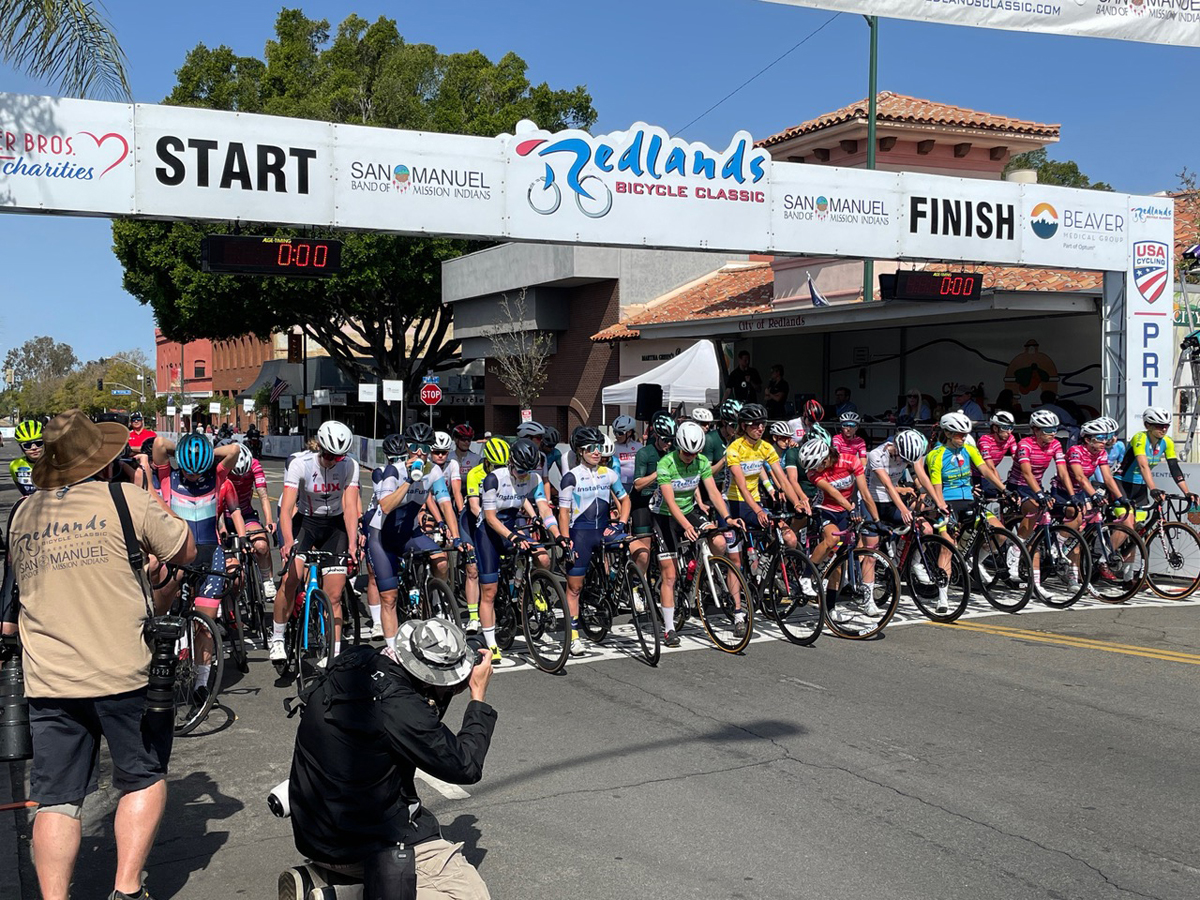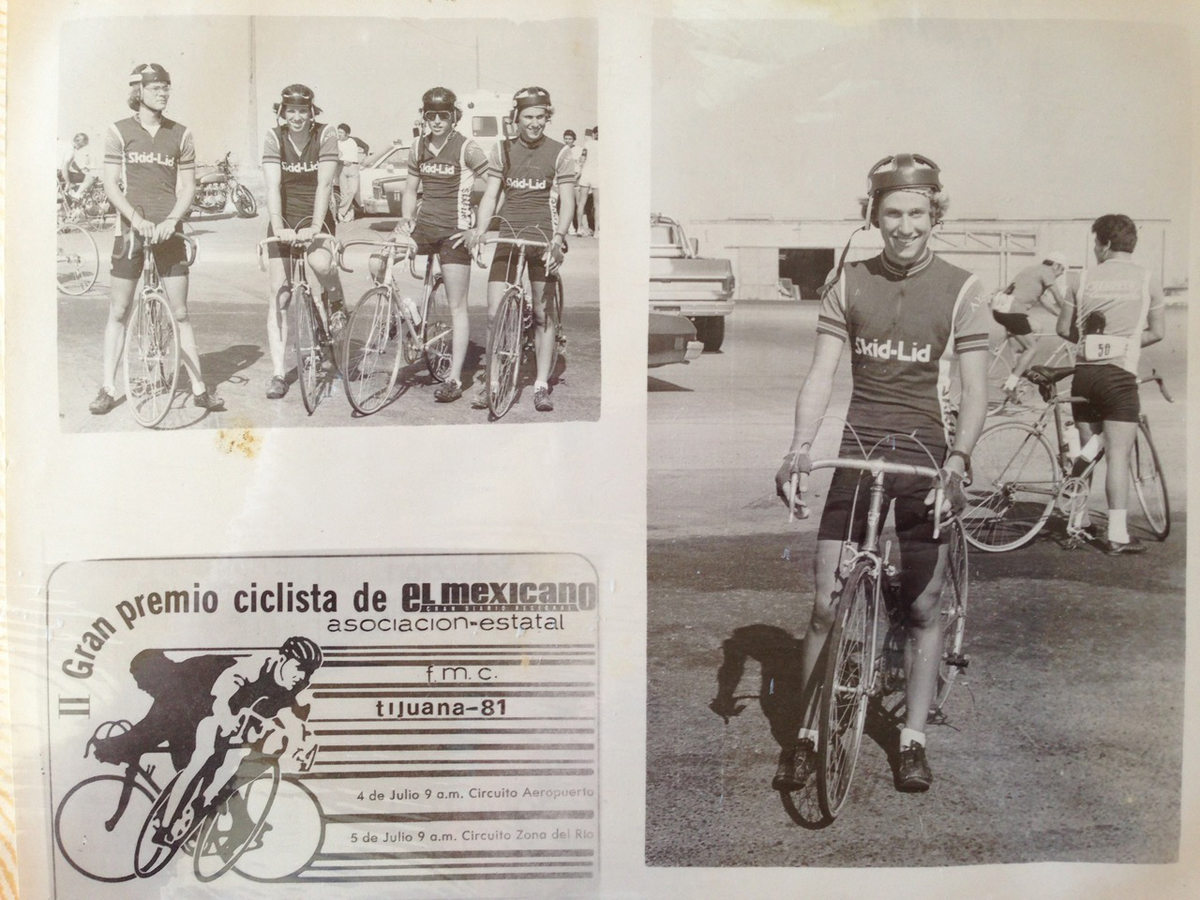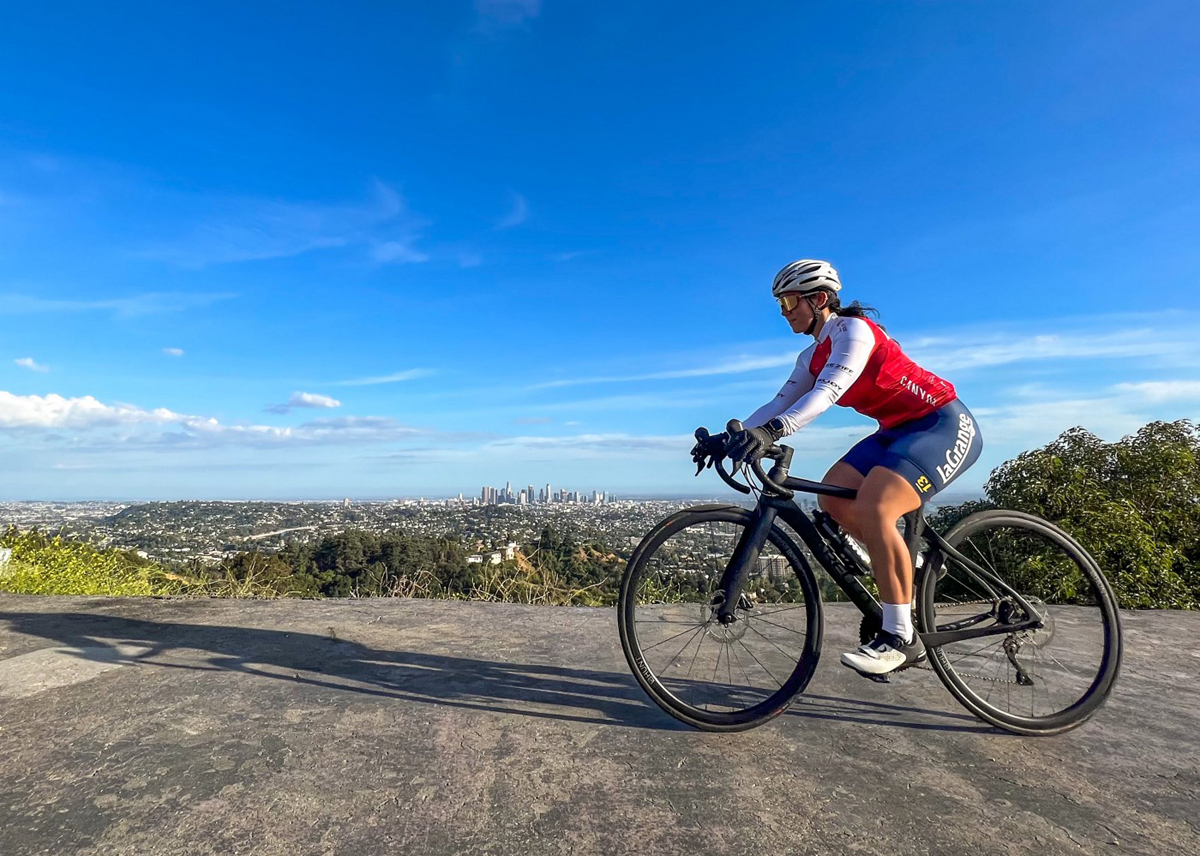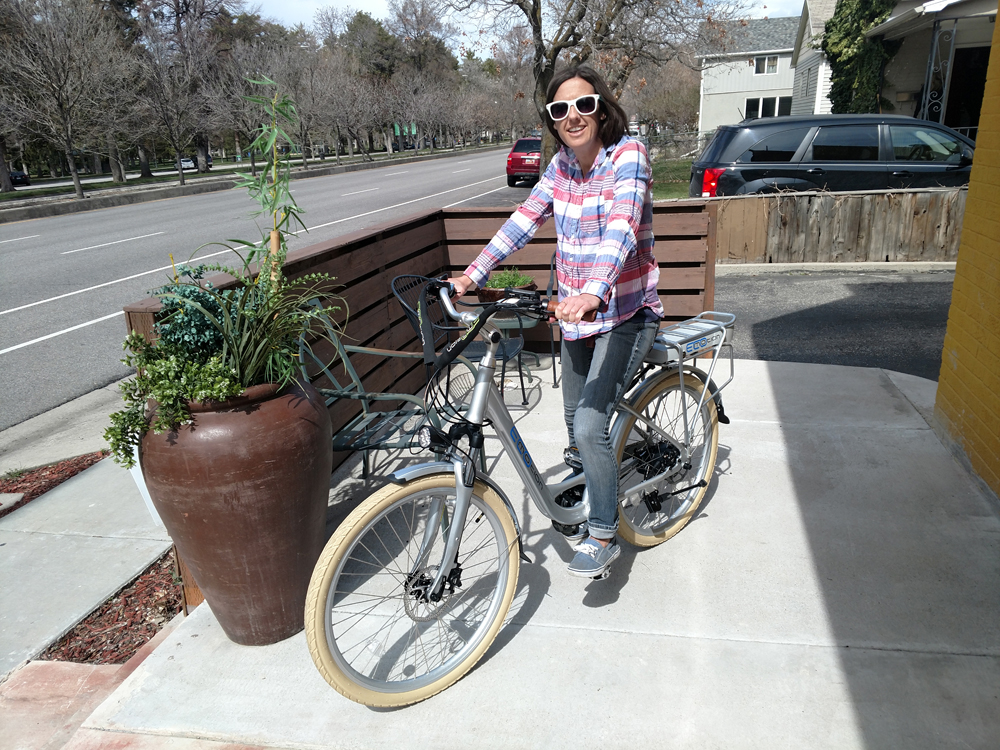By Peter Abraham — Recently, I drove out to the City of Redlands to watch a stage of the venerable Redlands Classic stage race. It’s one of the longest-running bike races in the country. Started by the former mayor and some volunteers after the 1984 Los Angeles Olympics, it was a tool to revitalize the city’s downtown area. It grew and grew and along the way has hosted many top international riders and teams and become a staple of the domestic bike racing calendar. But since its peak about 10 years ago, road racing in the US has been on a steady decline. I decided to get out to the races and take the temperature of the sport.
First, let’s define “bike racing.” I’m talking about road racing, separate from gravel, cyclocross, track, bmx and mountain bikes. This is what the public mostly perceives the sport to be: The Tour de France, lycra, European roots. And I have to ask: Is this sport relevant in the US anymore? To what extent does it exist? Who participates? Can it even be brought back? And does it matter — do we need traditional bike racing here as a sport?

The sport of cycling reached its zenith in the American public consciousness in the early Lance Armstrong era, circa 2001. For many, many reasons the sport has been on a gradual downward slide since then. There are currently only three US races aligned with cycling’s global governing body, the UCI: Tour of the Gila, the Walmart Joe Martin Stage Race and the new Maryland Cycling Classic. All of the World Tour cycling teams are based in Europe, and increasingly so are the smaller American teams. Why would the Human Powered Health team (with a World Tour women’s team and lower level Pro Team men’s program) schlep all the way back to the States for two small stage races in May when they have much, much bigger events in Europe?
I would argue that road bike racing is important, but it badly needs to evolve in the US. The sport is currently stuck in a 1970s model that is dated and unappealing to younger generations that we need. The top end of the sport is the one that’s seen around the world, the Tour de France, the Olympics, the World Championships. I love all forms of bike riding, including the non-competitive ones, but it’s uniquely inspiring to have American athletes racing in the world’s biggest races. There are lots of ways to play basketball as well, but one cannot deny the excitement of watching NBA players go head to head in the playoffs. Or watching World Cup soccer. The pinnacle of any sport is empowering and exciting.
Here’s my 10-point prescription to improve bike racing’s chances of survival in the US:
1. Understand current tradewinds in sport participation
For the past 16 years Google Trends has shown a steady decline in all keywords related to bicycle racing, except the term “gravel cycling.” Endurance sports popular with baby boomers have been on a downward slide for a long time. Not pictured here but suffering from the same decreasing participation (at least until the pandemic): golf, tennis and marathons. Let’s be honest about what’s appealing to bike riders and what’s not. The younger generation wants social first and competition second. Traditional bike races and triathlons are prioritized for the opposite. Gravel races, however, have nailed the social/community/fun/inclusion angle and are therefore booming. So what can road racing learn from gravel?
2. Beware the Boomer Bubble
I was born in 1963, so I’m right on the cusp of the baby boomers and Gen X. I started racing my bike in high school, had a chance meeting with Greg Lemond while he was training in my little town North of San Diego, and I’ve been on my bike ever since. I followed his meteoric European career, then watched the American rebirth of bike racing in the late 90s/early 2000s. I participated in masters road racing in my 40s and now I love gravel events.
I’m part of the “boomer bubble” that’s moved through the sport. When I raced as a junior, fields were regularly over 100 in my races. That’s unheard of now. When I raced as a 43 year old masters rider, fields were really big as well. Race fields for riders younger and older than me were smaller. But I was in the bubble. And now that I ride in gravel events, my 50–59 age group is often the biggest field in the race. I recently participated in the excellent Huffmaster mixed gravel/road event in Northern California, and my 50+ field was much bigger than any others. My “old guy” bubble is not going to be racing bikes much longer. So what fills the void when we’re out of the sport?

3. Help create events with newer, younger & more diverse leadership
The same boomer bubble also describes many of those who organize bike races, run sanctioning bodies, own the media channels and bicycle brands: It’s mostly a bunch of old, white men. Not entirely, but this describes the majority. Is it any wonder that the participants at bike races look like everyone else in leadership positions in the sport? Should we be surprised that while the country has gotten more diverse, more digital, younger and into different sports that bike racing has been stuck in a 1985 time warp? No, we should not. (Full disclosure: I’m part of this problem, as a middle aged white dude in the sport.)
4. Experiment with different race formats
I look at the tried-and-true stage race template of time trial/road race/criterium and I ask, “Why?” I think if you asked most race directors why they stick with this format they’d say, “Because it’s the way it’s always been done.” But is this the best way forward? Road races are logistically complex and expensive to put on and time trials are exciting neither for participants nor spectators. Criteriums work on the other hand, because they’re spectator friendly, easier to broadcast and operationally simpler than longer events. Here in LA we have the CicLAvia open streets event, which has seen over 1.6 million participants in 12 years. Could one of their events be combined with a bike race? What about a road+gravel stage race? Could we start an eBike Zwift league in high schools? This is part of a longer discussion, but the point is this: why are we not creatively exploring other avenues for the sport?
5. Collaborate closely with NICA to build pathways into other areas of cycling
NICA (the booming high school mountain bike racing league) is great, and it’s onboarding many teenagers onto bikes and competitive endurance sports. I’m a huge fan of this initiative. And if you look at Americans racing professionally in Europe — Kate Courtney, Megan Jastrab, Sepp Kuss, Kevin Vermaerke — most of them started in this league. But that is somewhat accidental, as there is no formal connection between NICA and other forms of cycling. Why can’t we build a pathway to road racing, criteriums, gravel, and college cycling? If you compare cycling with track & field, you can quickly see how broken the cycling development path is: Almost every high school in America has a track (and probably cross country) team. If a student wants to keep running at the next level, there are approximately 1,000 college track programs in the US. While NICA is growing fast and creating opportunities for high school kids to race bikes in over 30 states, the next level is almost non-existent. That development pathway needs to be built from scratch.
6. Rebuild College Cycling
College cycling as currently organized is broken and set up to fail. It doesn’t look much different now than it did when I raced for the UC Davis Aggies cycling team in the early 80s. I recently was speaking with some members of the UCLA cycling team over coffee. They were sharing with me how challenging the college cycling landscape is: most teams are all-volunteer club sports with students who may not be able to afford equipment and have to organize and promote their team’s bike races. The UCLA team explained that a recent race at another school had been canceled because the team just could not pull off the logistics. It’s too much to ask. As a college student, it’s hard enough to get out and train let alone manage and build a team and organize logistically complex events. While there are a few well-funded varsity programs (Lees-McRae, Marion University, Fort Lewis College are examples), these are few and far between. As long as college cycling is a DIY club sport model, it is destined to limp along with no coaching continuity and a lack of centralized leadership at either the school or national levels.
7. Welcome beginners into the sport
While at the Redlands Classic race, I spoke to my new friend Arielle Miller of Velo Club LaGrange here in Los Angeles. I’ve ridden with that club on and off for years. It’s a local institution. Arielle just got into cycling during the pandemic. She’s incredibly passionate about it, and has already done a bunch of racing. But she and I spoke a lot about how cycling clubs generally do not welcome inexperienced riders. I’ve seen this first hand all over the country. Group rides are fast and intimidating. There should be group rides like that. As an experienced rider, I love them. But there should also be no-drop, slower paced rides with leaders and an emphasis on fun and learning. And many cycling clubs completely fail here. Imagine a ski resort with only black diamond runs that wonders why more skiers don’t show up. That’s what lots of club cycling looks like. Clubs should be much more focused on bringing in new riders, women, people of color and young riders.

8. USA Cycling needs to prioritize what it can realistically focus on
USA Cycling, the governing body of the sport domestically, has recently undergone a leadership change. Cycling business veteran and lifelong bike enthusiast Brendan Quirk has taken the reins as President and CEO of the organization. I got to meet with him in person in Bentonville earlier this year during the World CX Championships, and I subsequently participated in a call he led for USAC coaches. I think the strategy he outlined then for the organization moving forward is smart:
- Re-energize American bike racing
- Expand and retain audience
- Deliver performance success
- Develop sustainable revenue streams
- Spearhead growth and diversity
The challenge is, how does he execute on all of these given the current trends in the sport? With limited resources, USAC can’t fix every problem. So what do they focus on? And how do they balance the need to win medals now with the need to fill the pipeline and grow the sport at the grassroots level. I don’t have the answer, but he’ll only be able to succeed if he lines up enthusiastic support from all of his stakeholders. I’m rooting for him.
9. Help cycling events get better at media
Younger riders, whether from high school, college or in their 20s are media savvy and highly attuned to social media and sophisticated storytelling. How many cycling events are aligned with this? I spoke with bike racing announcer and broadcast producer Brad Sohner when I was at Redlands. He asked me, “How many cycling events are on TikTok?” The answer is almost none of them. As a media and marketing professional, I’m always looking at how brands, athletes and events execute on digital channels. And with bikes I’m usually shocked at how poorly the events communicate. I can sympathize with overworked volunteers who are just trying to get racers to the starting line, let alone put together a marketing campaign or communications strategy. I once had my own 5K/10K run as a sidehack, so I know how challenging this is. But if we want to invite new riders into the tent, we need to speak to them in their native language. Professional media and storytelling execution are both mission critical. A couple recent examples of bike race websites I’ve seen, the Joe Martin Stage Race and the Speedweek criterium series, had no news posted for months even though it was only weeks before the event or are missing the results.
10. Continue to make diversity and inclusion essential priorities in cycling
If there’s one thing I’ve learned in decades of work with diversity programs, it’s that no new communities will join a sport unless intentional onramps are built. The reason 30,000 kids are racing bikes with NICA is that the founders had the foresight and energy to do fundraising, train coaches, add new regions, build brand partnerships and more. It’s taken a huge amount of work to get that program to where it is today. It will take even more work to create sustainable populations of women, people of color and LGBTQ communities in cycling. I love what Justin Williams is doing with his L39ion of Los Angeles team. I love that St Augustine’s University (I worked with them) has created an HBCU cycling program. I love that Rebecca Rusch added a non-binary/trans division at her RPI gravel race (I worked on this, too). I love what Triangle Bikeworks is doing with kids in North Carolina and how Silver Stallion is bringing bikes to Navajo Nation. I love what Grow Cycling is doing with pump tracks in cities. But combined, these initiatives and many others are less than 1% of the way to making bike culture fully diverse. And I still see huge mistakes being made, like the new Maryland Cycling Classic launching a men’s only pro race. I’m sure they eventually want to include women’s teams, but why not now? Can you imagine a professional marathon kicking off with a men’s only race? There’s much, much more work to be done.









Yes, I am one of those old white guys (66) who still love the idea of road racing, and wish things could continue as they did from the 70’s and into the early 2000’s. I still think that the road racing “template” works, but that too many folks have been put off by their perception (probably correctly) that riding a bike on public roads is too dangerous to their well being. That, I think, is a HUGE detriment to road bike riding, not just racing. WE NEED TO CHANGE THIS! The biking community NEEDS to engage the driving community in understanding that bikes are not the enemy and that all users of the road need to be treated with respect and courtesy… (yeah, right)…
Many in the younger generation are not interested in exercise and are overweight. Too much phone and computer time. Basiically racing needs to be “cool” again. I’ve no idea how to do that.
Robert Ray touched on a sad truth: driving on the road is dangerous. Even during organized road races where visibility is enhanced and people should be aware of the cyclist traffic, unless the roads are closed (which most of the time won’t be for amateur events) motorists present a hazard to cyclists.
Another truth, as mentioned in the article, is that most clubs could be better at welcoming and teaching new cyclists. That being said, the more experienced riders want to ride hard and fast and make the most of their time. It’s hard to find non-retired ride leaders who have time to volunteer to coaching and leading the rides that beginners need.
A local race director in Utah is making headway on his events by offering a fondo option with his regular races. What a great idea! The fondo option offers an opportunity for anyone to participate in the event without the pressure of competition (although it’s always a competition, right?), and racers can get their fix at the same time.
The “after party” element of events is also an important aspect that os often overlooked. Participants want to race, but then afterwards they want to share stories of their mechanicals, getting dropped and having to chase for miles, or brag about their massive pulls and close calls. Events should plan an opportunity for this to happen, because doing so gets participants excited to come back next time and do better.
Europeans support cycling everywhere and it shows in their infrastructure, their local events, and everywhere else. In the US, the bicycle just isn’t widely accepted as a mode of transportation like it is in Europe. Americans are too impatient and unwilling to pay for wide shoulders that double as a bike lane, let alone dedicated lanes.
Improve the events, delete the lycra stigma, and work with local cities and towns to improve signage about bicycles as well as safety towards bikes on the road. These are just the start of how we can bring racing back.
Make cycling less expensive. It is hard for families to justify $1000 (or more) road bike for a growing child. Bikes are just too dang expensive.
Gravel is popular because in large part it takes you off the pavement and away from cars. Until we restrict and get serious about safety for cyclists on the roads (cell phones) road cycling will not make a return.
You’ve nailed all the issues! We are a family participating in NICA, and my question is, “What will my son and daughter do after high school & NICA?” You mentioned there is a grand total of THREE college programs with funded cycling teams in the US. Slim pickings! It’s clear that NICA has set the bar, and there is a demand for more options for MTB in college. Kids shouldn’t have to narrow their educational options just to continue competitive cycling in college. I understand the challenge Quirk and USAC have in front of them. But, they could also do some work to improve their PR and education strategy for the many NICA families wondering how these two organizations are related. The absence of info sends the message that these organizations do not communicate with each other. If they want to take advantage of the fact that NICA will continue to be a place to find young talent, it would be wise of them to at least reach out to the kids who are top NICA performers, which I have not yet seen.
– from a parent wondering what happens after NICA
Comments are closed.